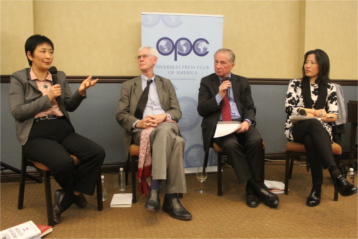Event Coverage Highlight

Experts Discuss China’s High-Tech Business Ambitions
By Chad Bouchard
In 2015, China raised eyebrows when it unveiled an aggressive “Made in China 2025” plan to modernize the country’s industries over the next decade, with a focus on advanced technologies and innovation.
On Wednesday, Nov. 16, the OPC, the National Committee on U.S.-China Relations, the Asia Society’s ChinaFile and Silicon Dragon co-hosted a forum to discuss the outlook of this ambitious proposal and prospects for transformation.
“This is an extraordinary undertaking,” said William J. Holstein, who moderated the panel. “They’re trying to force the pace of change so that they can create new jobs, new high-quality, value-added jobs that will replace the jobs that are going off to Vietnam or Cambodia.”
He asked panelists to address whether China would be able to innovate technologically on a global scale in private-business sectors.
“So far, China has largely borrowed Western models – Google and so on – and adapted them to the Chinese market, driven down the cost of cell phones, or done things that we would regard as sort of derivative, but not fundamentally breakthrough innovation,” he said. “There are some impressive things, technologically, in the state sector, but I think that from an American perspective, what we’re interested in is whether non-state players can innovate rather than just borrow.”
Yu Zhou, co-editor of China as an Innovation Nation and professor of geography and Asian studies at Vassar College, cautioned against defining innovation too narrowly as merely individuals who discover breakthroughs. She said innovation often arises from groups of people working in related areas and building on each other’s work.
“If we go with that definition, thinking about innovation as a cumulative, collective process, I think China has done a lot in terms of moving into innovation.”
Weiping Wu, a professor of urban planning at Columbia University, said research funding doesn’t flow from the Chinese government to universities, but it flows to public research institutes.
“The enforcement of intellectual property rights can be actually a hindrance for countries and regimes that are going through adaptation and hence it’s only more recently you see the rapid growth of patent applications in China.”
Zhou added that although China’s patent laws are not as robust as those in the West, there are still practical barriers that keep firms from stealing high-tech ideas.
“You might have this wonderful idea to build high speed rail, but can you really easily steal that? You need a lot of other associated sectors” and overcome high cost of entry to bring innovations to market.
Orville Schell, the Arthur Ross Director of the Center on U.S.-China Relations at Asia Society, said though China’s system is closed compared to the free-wheeling market that Westerners are accustomed to, he is amazed at the “energy and enterprise seething around at all levels of China’s model.”
He suggested that frustrations and bureaucratic hurdles could be fostering “Darwinian strength” among those who can survive those challenges.
“I wonder if the power of Chinese ingenuity and innovation doesn’t in some weird way come from the fact that the Party makes it so damned hard. Only people who really persevere, really struggle – when they succeed, that’s quite an accomplishment.”
Zhou said her research showed that China’s top-down model succeeded in concentrated sectors like high-speed rail, but “failed miserably” in other sectors like automotive and semiconductors where there is high competition and an active international market.
“It’s not as if the Chinese model will be successful every time. Actually most of the time, that top-down system did not succeed,” she said, adding that necessity could push China in a direction that the United States doesn’t need to.
“What I’m hoping China is able to do is create certain industries, certain technologies that can address something that is important to China but also for the world. For example, in the environmental field, could China develop certain technology or deploy or adapt better technology that may address environmental issues which are huge in China.”
With the election of Donald Trump as President of the United States just one week earlier still fresh in the minds of panelists, Holstein asked the group to comment on the potential effects of U.S.-China relations.
Schell compared Trump to the current president of the Philippines, Rodrigo Roa Duterte, as part of a global move in some countries toward “a new thugocracy.”
“The virtue of a thug is that they move in unpredictable ways. And they break up old paradigms, sometimes they wreck the furniture and they but sometimes they can manage to do very surprising things. I’m ready to be both surprised and horrified.”
Zhou said Chinese observers were fascinated by the U.S. election, and said she saw a prevailing idea that Trump might not be as confrontational as the current administration, “since he is a merchant, and merchants deal with money and nothing else.” Hillary would have been more predictable, she added, even if she would have been predictably unfavorable.
Holstein said while Trump’s effect on the relationship between China and the U.S. is unknown, the two countries are too intertwined for shockwaves to completely sever longstanding ties.
“The depth and complexity of the relationship is something that has taken all these year to develop. It seems unlikely to me that Trump can blow that up overnight.”
But he added that there is still potential for disruption. “It a moment of extreme fluidity in the relationship.”




